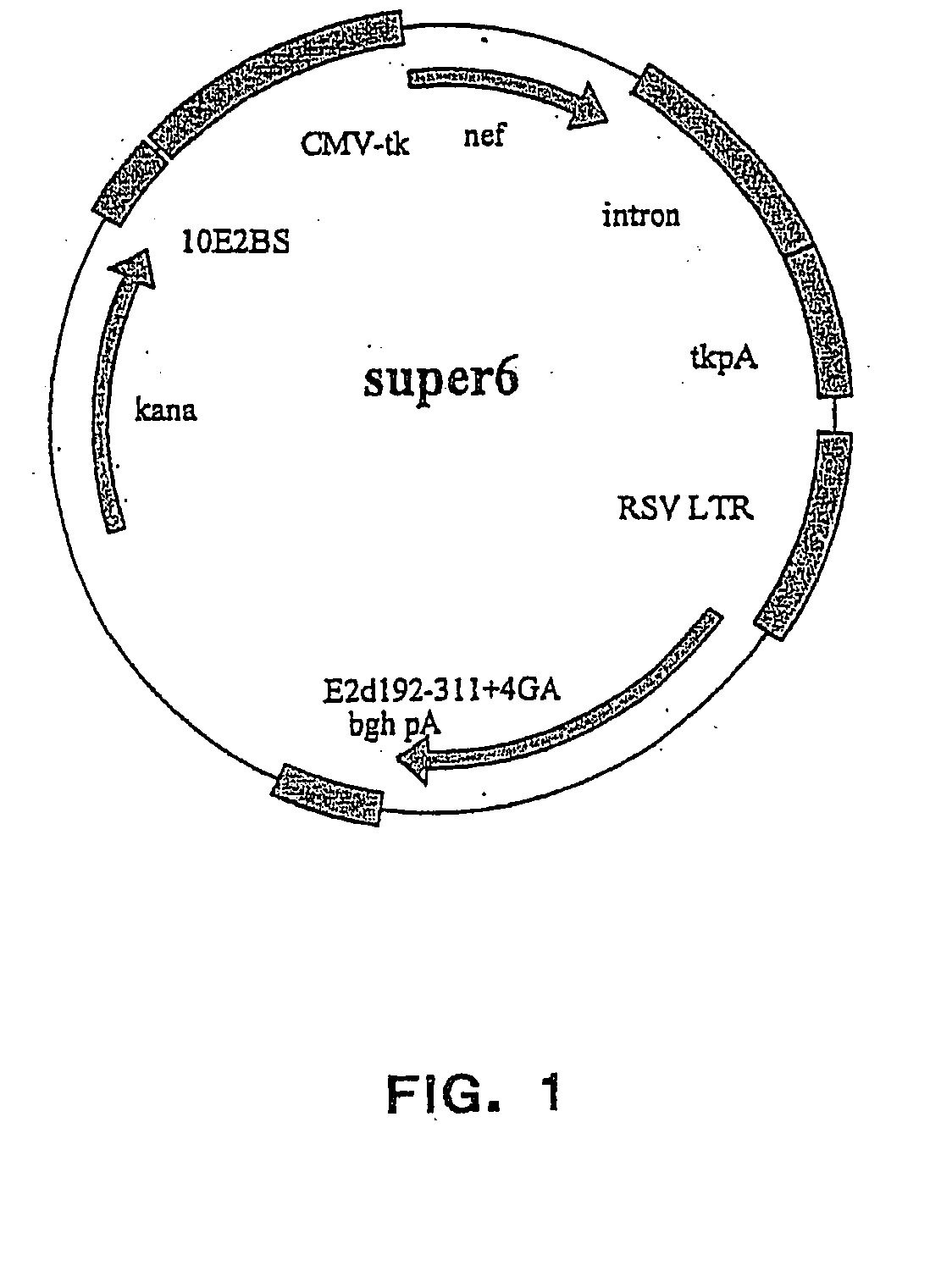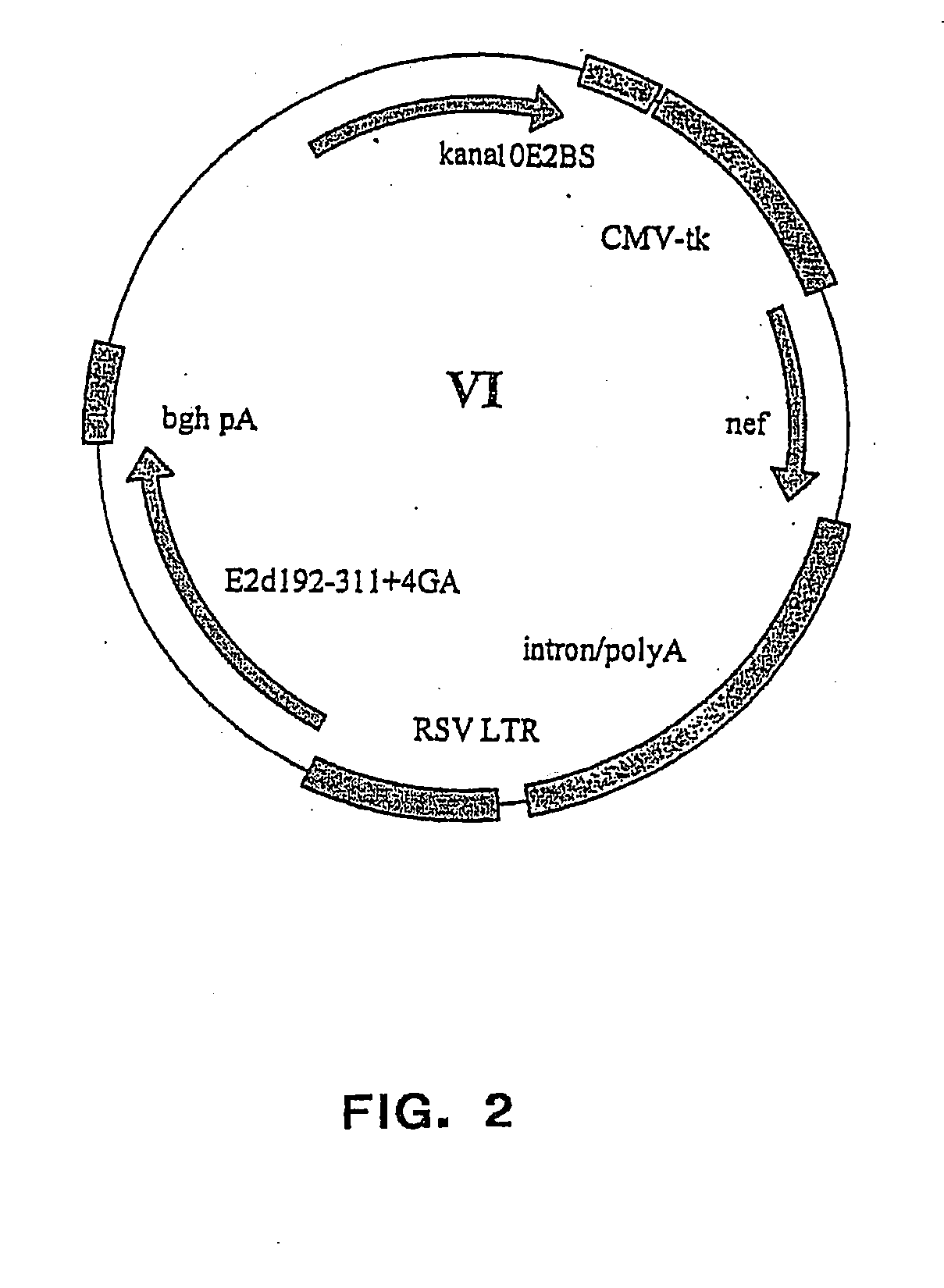Novel expression vectors and uses thereof
a vector and expression technology, applied in the field of new vectors, can solve the problems of short-lived expression obtained by these vectors, unsatisfactory side effects, and inability to be as potent as the live vaccin
- Summary
- Abstract
- Description
- Claims
- Application Information
AI Technical Summary
Benefits of technology
Problems solved by technology
Method used
Image
Examples
example 1
6.1. Example 1
Cloning and Analysis of the Expression Properties of the Vectors Super6 and Super6wt
[0249] The vector plasmids super6 (FIG. 1) and super6wt were prepared from previous generation based gene vaccination vectors VI (FIG. 2) and VIwt, respectively. Vectors VI and VIwt are principally synthetic bacterial plasmids that contain a transposon Tn903 derived kanamycin resistance marker gene [Oka, A., et al., J Mol Biol 147 (1981) 217-226] and a modified form of pMB1 replicon [Yanisch-Perron, C., et al., Gene 33 (1985) 103-119] needed for the propagation in Escherichia coli cells. Vectors VI and VIwt also contain a Cytomegalovirus Immediately Early Promoter combined with a HSV1 TK leader sequence and rabbit β-globin gene sequences, which both are derived from plasmid pCG [Tanaka, M., et al., 60 (1990) Cell 375-386]. The latter elements are needed for expressing from the nef coding sequence derived from a HAN2 isolate of the HIV-1 strain [Sauermann, U., et al., AIDS Research. Hum...
example 2
6.2. Example 2
Cloning and Analysis of the Expression Properties of Plasmids in Series Product1 and NNV
[0256] To increase the copy number of the vectors super 6 and super6wt in Escherichia coli further modifications were made in these vectors. The Tn903 kanamycin resistance gene, pMB1 replicon and ten E2 binding sites were removed by HindIII / NheI digestion followed by replacing with the Hind III / NheI fragment from retroviral vector pBabe Neo [Morgenstern, J. P. and Land, H., Nucleic Acids Research 18 (1990) 3587-3596]. This fragment contains a modified pMB1 replicon and the Tn5 kanamycin resistance gene that allow relaxed high copy-number replication of the plasmids in bacteria. The new plasmids were named as the product1 (FIG. 5), and product11wt respectively. An unsuccessful attempt to reinsert the ten E2 binding sites back into the blunted Nhel site upstream of the CMV promoter of the product1 resulted in vector New Vector NNV, respectively, with only two binding sites integrated...
example 3
6.3 Example 3
Analysis of the Expression Properties of NNV-2wt
[0260] To analyse the expression properties of NNV-2wt, four different cell lines, i.e. the Jurkat (human T-cell lymphoblasts), P815 (mouse mastocytoma cells), CHO (Chinese Hamster Ovary cells) lines and RD (human embryo rhabdomyosarcoma cells), were transfected by electroporation and analyzed for their expression of Nef of and E2. To reveal the transcription activation and maintenance properties mediated by E2 protein and E2 oligomerized binding sites product1wt, which lacks the E2 binding sites (FIG. 5), was used as a control. An additional control plasmid was plasmid NNV-2wtFS, which differs from NNV-2wt by containing a frameshift introduced into E2 coding sequence, whereby it does not express functional E2 protein.
[0261] Each cell line was transfected with different amounts of the vector DNA by electroporation essentially as described in Example 1. Time-points were taken approximately two and five days after transfec...
PUM
| Property | Measurement | Unit |
|---|---|---|
| time | aaaaa | aaaaa |
| concentration | aaaaa | aaaaa |
| time | aaaaa | aaaaa |
Abstract
Description
Claims
Application Information
 Login to View More
Login to View More - R&D
- Intellectual Property
- Life Sciences
- Materials
- Tech Scout
- Unparalleled Data Quality
- Higher Quality Content
- 60% Fewer Hallucinations
Browse by: Latest US Patents, China's latest patents, Technical Efficacy Thesaurus, Application Domain, Technology Topic, Popular Technical Reports.
© 2025 PatSnap. All rights reserved.Legal|Privacy policy|Modern Slavery Act Transparency Statement|Sitemap|About US| Contact US: help@patsnap.com



